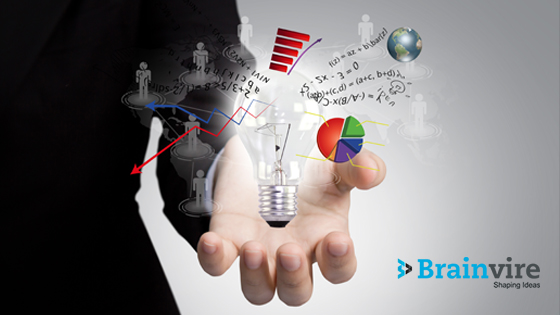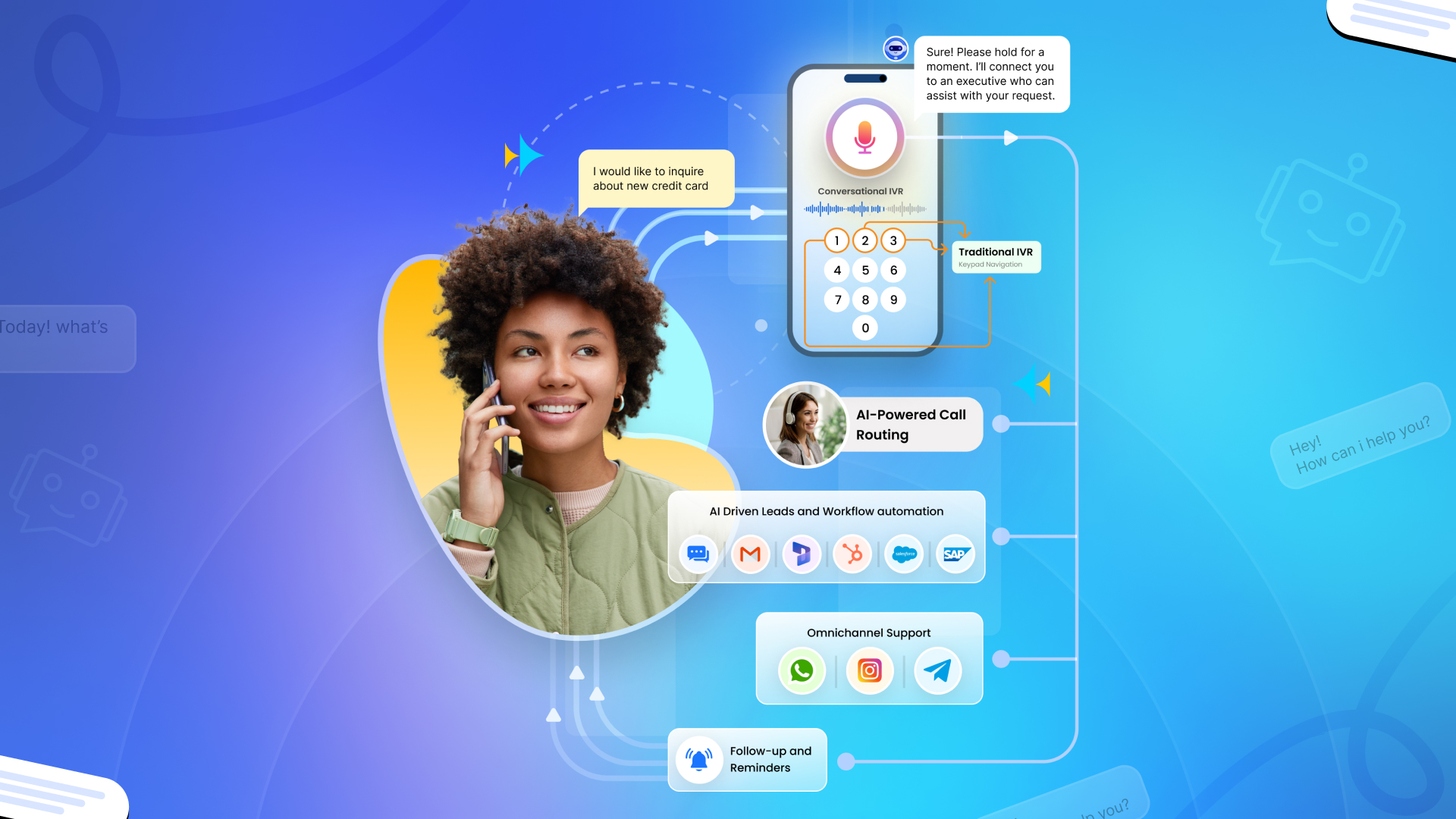As an entrepreneur, you will always seek strategies and solutions to take your business to the next paradigm. Doing that is not easy, as identifying tools and methods to multiply your business success is not easy and requires research. However, what if we save you all the effort and open the Pandora box, which has it all? Digital Product Engineering is one innovative solution you can leverage to target your audience and match their expectations.
Digital product engineering has become a cornerstone of modern business innovation, reshaping how companies ideate, develop, and bring products to market; in a world driven by rapid technological advancements, traditional product development processes struggle to keep pace with the demands for faster, more efficient, and scalable solutions. Digital product engineering addresses these challenges by combining cutting-edge technologies like cloud computing, artificial intelligence (AI), data analytics, and user-centered design with Agile testing services.
At its core, digital product engineering is not merely about building software products; it’s about transforming concepts into solutions that meet evolving market needs. Businesses can accelerate innovation and maintain a competitive edge by integrating customer feedback loops, iterative design, and data-driven insights. Digital product engineering plays a pivotal role in every phase, from ideation to post-launch updates, ensuring that products are user-friendly, secure, and scalable.
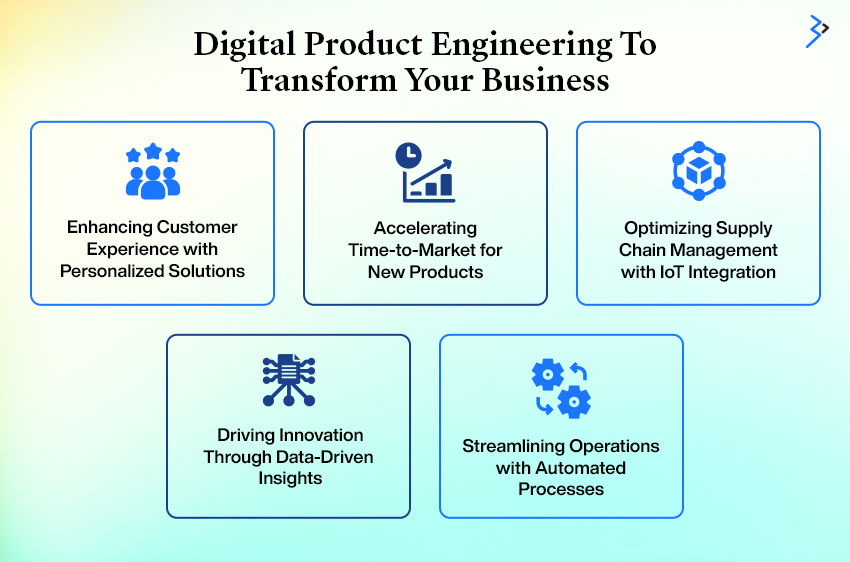
How Can Digital Product Engineering Transform Your Business?
- Enhancing Customer Experience with Personalized Solutions
Today’s consumers expect personalized, seamless interactions with brands, whether shopping online, accessing services, or interacting with a mobile app. Digital product engineering enables businesses to develop solutions tailored to individual customer preferences, elevating the user experience.
Suppose a retail company aims to boost customer engagement by offering personalized shopping experiences. In that case, it can build a mobile app powered by AI and machine learning by leveraging digital product engineering. This app can analyze customer behavior, preferences, and purchasing patterns, allowing it to recommend products, offer personalized discounts, and deliver a more enjoyable shopping experience. This leads to increased customer satisfaction, loyalty, and, ultimately, higher sales.
Personalization through digital products is not just a feature; it’s a competitive differentiator. By tapping customer data, businesses can create unique, curated experiences beyond traditional offerings.
- Accelerating Time-to-Market for New Products
We know that speed is crucial in a rapidly evolving market. Companies that can quickly launch new products or features have a competitive advantage over those that rely on slower, traditional development cycles. Digital product engineering allows businesses to accelerate time-to-market by adopting Agile methodologies, DevOps practices, and continuous integration.
When a software company is compelled to release new features faster to stay ahead in a competitive environment, digital product engineering is the go-to solution. Using agile processes and automated testing, the company can streamline the product development cycle. This results in quicker iterations, faster releases, and the ability to adapt to market trends, ensuring the company stays relevant and competitive.
In today’s dynamic markets, pivoting and responding quickly to consumer demands is critical. Digital product engineering equips businesses with the tools and processes to innovate faster and more efficiently.
- Optimizing Supply Chain Management with IoT Integration
Supply chain inefficiencies can lead to costly delays, inventory mismanagement, and reduced customer satisfaction. Digital product engineering can address these issues by integrating the Internet of Things (IoT) and data analytics into the supply chain, enabling real-time tracking, predictive maintenance, and seamless communication across various stages.
For example, a manufacturing company needs help with delays and inefficiencies in its supply chain, leading to increased operational costs. The company integrates IoT sensors into its supply chain processes through digital product engineering, enabling real-time monitoring of inventory levels and equipment performance. The result is better logistics coordination, reduced downtime, and more efficient operations.
By embedding IoT and other intelligent technologies into supply chain management, companies can optimize resource allocation, improve decision-making, and deliver products to market faster, driving cost savings and customer satisfaction.

- Driving Innovation Through Data-Driven Insights
Data is one of the most valuable resources in the digital age. Companies that harness data can unlock new opportunities for innovation, improving product performance and customer outcomes. Digital product engineering enables businesses to gather and analyze data at every stage of product development, allowing for continuous improvement and innovation.
When a healthcare provider seeks to improve patient outcomes through the effective use of data, it implements a digital platform powered by data analytics. This platform allows the provider to track patient health metrics, monitor treatment efficacy, and analyze outcomes in real-time. This enables the development of personalized treatment plans, early detection of potential health risks, and better overall patient care.
By making data central to product development, businesses can drive innovation, offer personalized solutions, and respond more effectively to user needs and market trends.
- Streamlining Operations with Automated Processes
Manual processes are often time-consuming, error-prone, and inefficient. Digital product engineering leverages automation to streamline operations, reduce errors, and improve efficiency.
For example, suppose a financial services firm grapples with slow, error-prone manual processes, particularly in data entry and compliance checks. By adopting automated workflows through digital product engineering, the firm can reduce human errors, improve the speed of its processes, and ensure compliance with regulatory requirements. This shift makes the company more agile and frees employees to focus on higher-value tasks, such as strategic decision-making.
Automation transforms industries by simplifying processes, reducing costs, and enabling faster decision-making. Adopting automated processes through digital product engineering is vital for businesses looking to stay competitive.
Key Components of Digital Product Engineering
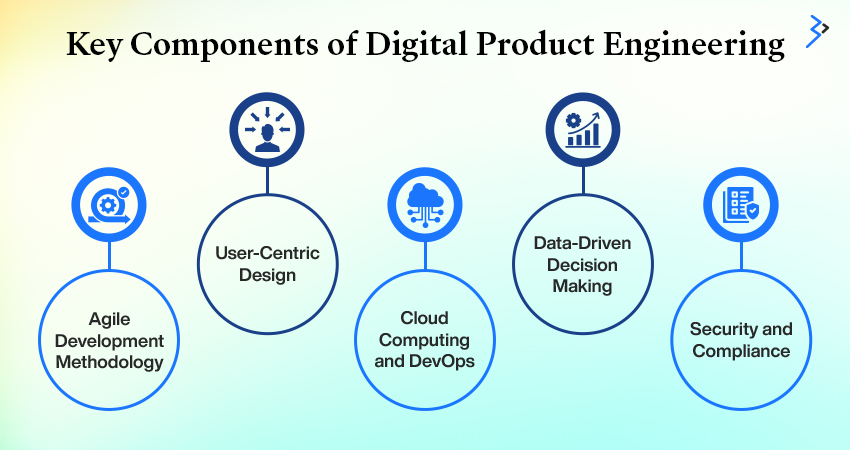
Digital product engineering is built on a foundation of critical components, each contributing to the overall success of the development lifecycle. These components ensure that products are scalable, secure, and user-focused while supporting rapid development and deployment.
- Agile Development Methodology
Agile methodologies are the backbone of digital product engineering, allowing for iterative, flexible, and adaptive development cycles. By breaking down projects into smaller sprints, development teams can prioritize tasks, track progress, and quickly adapt to changing requirements or feedback. This continuous development and testing ensure that products are launched faster and with fewer bugs.
Agile is particularly beneficial in complex, evolving environments where customer needs and technology trends shift rapidly. The methodology fosters collaboration between cross-functional teams and ensures regular feedback loops with users, leading to more refined, user-friendly products.
- User-Centric Design
One of the pillars of digital product engineering is a relentless focus on user needs. User-centric design emphasizes creating intuitive, accessible, and aesthetically pleasing products that address users’ pain points. The development process begins by understanding the target audience, mapping user journeys, and identifying key touchpoints that affect the overall experience.
Designers use wireframes, prototypes, and iterative testing to ensure that the final product meets users’ expectations regarding usability and functionality. A user-centric approach enhances the customer experience, reduces friction, and increases product adoption.
- Cloud Computing and DevOps
Cloud computing and DevOps practices are essential for scaling digital products efficiently. Cloud platforms provide flexibility and scalability, allowing businesses to scale resources up or down based on demand without significant infrastructure investment. This reduces costs while ensuring that applications can handle increased traffic or workloads.
DevOps, however, fosters collaboration between development and operations teams, ensuring faster delivery cycles and continuous integration/deployment (CI/CD). By automating testing, deployment, and monitoring, DevOps reduces time-to-market while maintaining high levels of quality and security.
- Data-Driven Decision Making
The ability to collect, analyze, and act on data is a critical differentiator in digital product engineering. With advanced data analytics, companies can gain insights into customer behavior, operational efficiency, and market trends. These insights enable informed decisions that drive product improvements, personalization, and optimization.
Data-driven decision-making also plays a role in predictive analytics, allowing companies to anticipate user needs or potential system issues before they arise. Businesses can mitigate risks, increase customer satisfaction, and drive innovation by making decisions based on empirical data.
- Security and Compliance
In a world where data breaches and cyberattacks are rising, security and compliance are non-negotiable components of digital product engineering. Security measures must be integrated throughout the development lifecycle, from design to deployment. This includes encryption, secure coding practices, and regular security audits to protect applications against vulnerabilities.
Compliance with industry regulations, such as GDPR or HIPAA, is also essential, especially for businesses operating in highly regulated sectors like healthcare and finance. Digital product engineering ensures these standards are met without sacrificing performance or user experience.
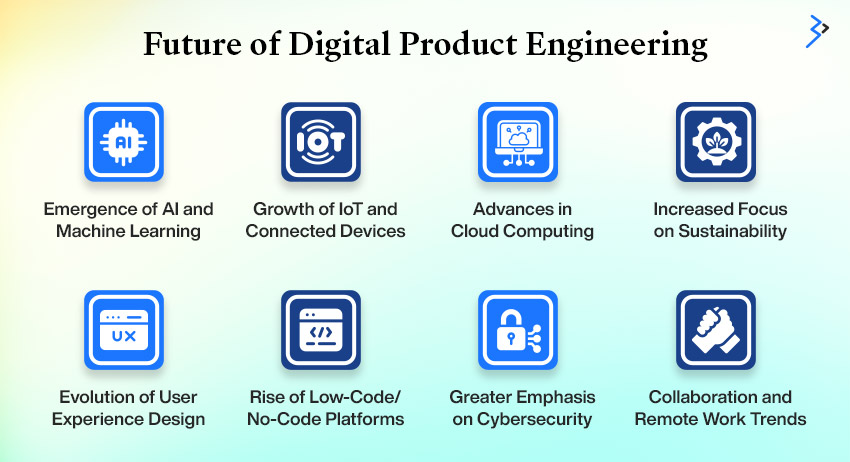
Future of Digital Product Engineering
The future of digital product engineering is promising, driven by advancements in AI, IoT, cloud computing, and a growing focus on user-centric design and sustainability. Let’s explore the key trends shaping this field:
- Emergence of AI and Machine Learning
AI and ML transform digital product engineering by enabling systems that learn, adapt, and improve over time. These technologies enhance automation, optimize the design process, and enable predictive maintenance. AI is also used to refine user interactions, powering chatbots and virtual assistants that provide more personalized experiences. As AI evolves, seamless integration into digital products will result in more intelligent, intuitive applications.
- Growth of IoT and Connected Devices
The Internet of Things (IoT) has redefined digital product engineering by linking various devices into an interconnected network, ranging from household gadgets to industrial machinery. This connectivity enables real-time data collection and analysis, allowing products to adapt dynamically to environmental changes. The healthcare industry, for example, benefits from IoT by enhancing patient care through real-time monitoring and data-driven decision-making.
- Advances in Cloud Computing
Cloud computing plays a pivotal role in digital product engineering, offering flexible and cost-effective resources for development and deployment. It enables real-time collaboration and provides platforms, infrastructure, and software as a service (SaaS). With cloud computing, teams can innovate faster and deploy products more efficiently, regardless of geographical location.
- Increased Focus on Sustainability
Sustainability is becoming a critical component of digital product engineering. Businesses are now designing products with eco-friendly materials, energy-efficient designs, and sustainable manufacturing processes to reduce environmental impact. This shift is driven by regulatory pressure and growing consumer demand for greener products, emphasizing a holistic approach to sustainability from production to disposal.
- Evolution of User Experience Design
User experience (UX) design is evolving rapidly, incorporating gesture controls, voice interfaces, and immersive technologies like A.R. and V.R. Designers leverage AI and data analytics to create personalized, seamless experiences across multiple devices. The goal is to improve engagement and satisfaction by tailoring interfaces to individual preferences, ensuring that user-centric design remains at the forefront of product engineering.
- Rise of Low-Code/No-Code Platforms
Low-code and no-code platforms democratize digital product development, allowing users without programming expertise to build complex applications. These platforms provide pre-built components and visual development environments, enabling faster prototyping and deployment. This trend helps businesses respond to market demands quickly while reducing development costs and timelines.
- Greater Emphasis on Cybersecurity
As cyber threats continue to rise, digital product engineers focus on integrating robust security measures into the development process. Secure coding, regular security assessments, and encryption are essential to safeguarding digital products. AI and ML further enhance cybersecurity by identifying potential threats and responding to them in real-time, offering a proactive approach to risk management.
- Collaboration and Remote Work Trends
The COVID-19 pandemic accelerated the shift to remote work, changing how product engineering teams collaborate. Communication platforms and project management software have become essential for distributed teams. Remote work allows companies to tap into global talent pools, increasing innovation and diversity. This trend is here to stay, driving a more flexible and collaborative approach to product development.
- Driving Business Growth with Digital Product Engineering
Digital product engineering drives business growth by enhancing operational efficiency, reducing costs, and enabling new revenue streams. Companies leveraging AI, cloud computing, and other advanced technologies can predict customer demands more accurately, develop personalized solutions, and improve overall user experience.
For instance, a leading U.K. retail bank implemented an AIOps-based solution that utilized AI to provide real-time insights and automate alerting systems. This improved transparency across hardware, networks, and applications, allowing decision-makers to act on relevant insights and enhance the customer experience in real time.
In another example, Domino’s Pizza transformed its business by adopting digital product engineering. By offering online ordering and mobile applications, 65% of Domino’s revenue in the U.S. now comes through digital channels, showcasing the potential of digital transformation to unlock new growth opportunities.
Traditional Software Development vs. Digital Product Engineering
| Feature | Traditional Software Development | Digital Product Engineering |
| Development Approach | Linear, waterfall model | Agile, iterative, and incremental |
| User Involvement | Limited to specific phases | Continuous user involvement and feedback loops |
| Scalability | Often an afterthought | Built-in scalability from the start |
| Deployment | Infrequent, with significant releases | Continuous integration and delivery (CI/CD) |
| Innovation | Slower, rigid processes | Encourages rapid prototyping and innovation |
| Security and Compliance | Addressed later in the process | Integrated throughout the development lifecycle |
| Maintenance | Separate phases with dedicated teams | Ongoing, integrated with development |
FAQs
- What skills are necessary for digital product engineering?
The key skills necessary for digital product engineering include expertise in software development, UI/UX design, cloud computing, AI/ML, data analytics, and strong problem-solving abilities.
- How does digital product engineering differ from traditional software development?
Digital product engineering focuses on end-to-end product lifecycle management, incorporating Agile development, AI, IoT, and cloud technologies for continuous improvement, whereas traditional software development centers primarily on coding and deployment.
- What role does cloud computing play in digital product engineering?
Cloud computing provides:
- Scalable, cost-effective infrastructure.
- Enabling faster development.
- Real-time collaboration.
- Seamless deployment of digital products.
- How can Brainvire ensure my digital product is secure and compliant?
Brainvire ensures security by implementing encryption, secure coding practices, regular security audits, and adhering to compliance standards like GDPR and HIPAA.
- What are the key benefits of adopting a digital product engineering approach? What is Brainvire’s approach?
Key benefits include faster time to market, improved customer satisfaction, scalability, and innovation. Brainvire adopts a customer-centric, agile approach, leveraging AI, cloud, and data analytics to deliver tailored, secure digital products.
Key takeaway
Emerging technologies like AI, IoT, cloud computing, and sustainability-focused design are driving the future of digital product engineering. These innovations enable businesses to deliver more imaginative products, enhance customer experience, and stay ahead of the competition.
Businesses embracing digital product engineering will meet customer expectations, scale faster, create new revenue streams, and build sustainable, long-term growth. By investing in the right technologies and processes, organizations can remain competitive in a rapidly evolving digital landscape. Contact us to learn more and get started with your digital transformation.
Related Articles
-
Prominence of Business Intelligence in the Success of Any Business
The world today is demanding smarter processing and use of technologies that can possibly automate or ease out every possible task. And many companies have started adopting business intelligence in
-
Various Applications of AI-powered Customer Contact Centers Across Industries
In today’s fast-paced digital world, businesses increasingly use artificial intelligence (AI) to revolutionize customer contact centers. AI applications are reshaping the customer service landscape, enhancing operational efficiency and the customer
-
Top Generative AI Content Writing Tools for 2025
Generative AI tools are transforming content creation across multiple industries by offering innovative solutions that enhance productivity and creativity. These tools assist marketers, writers, and businesses in producing high-quality content


